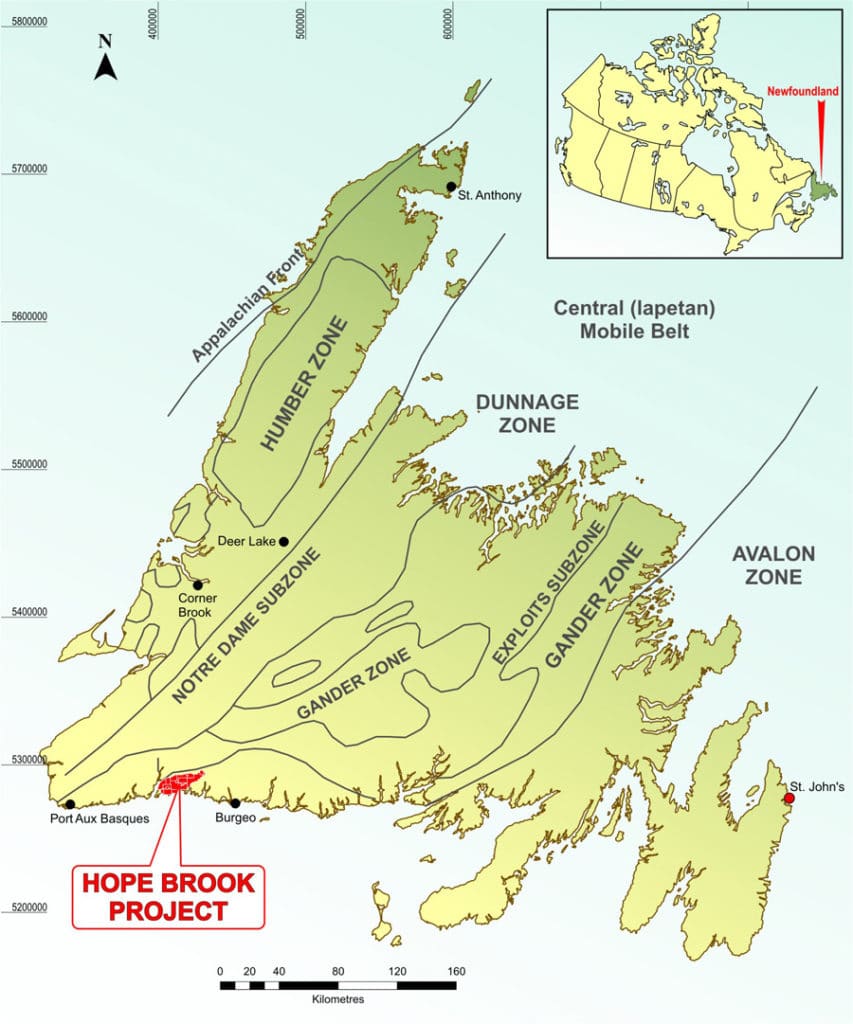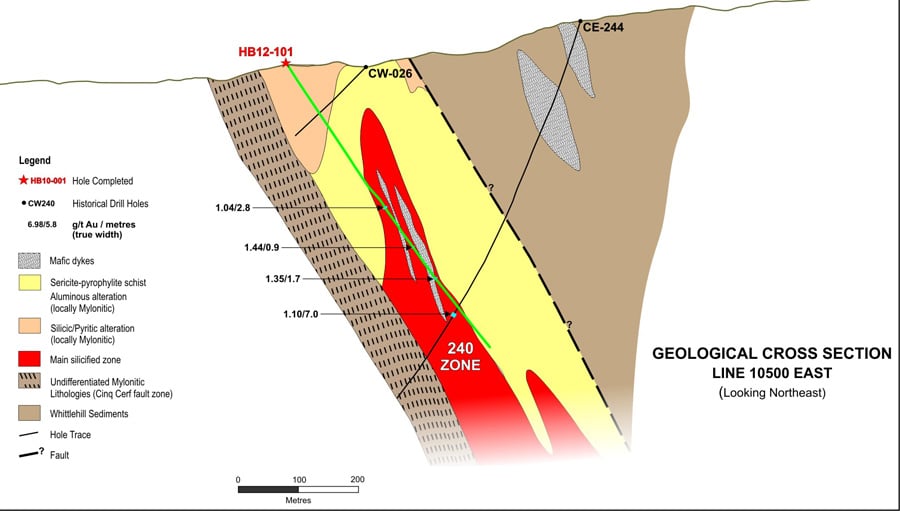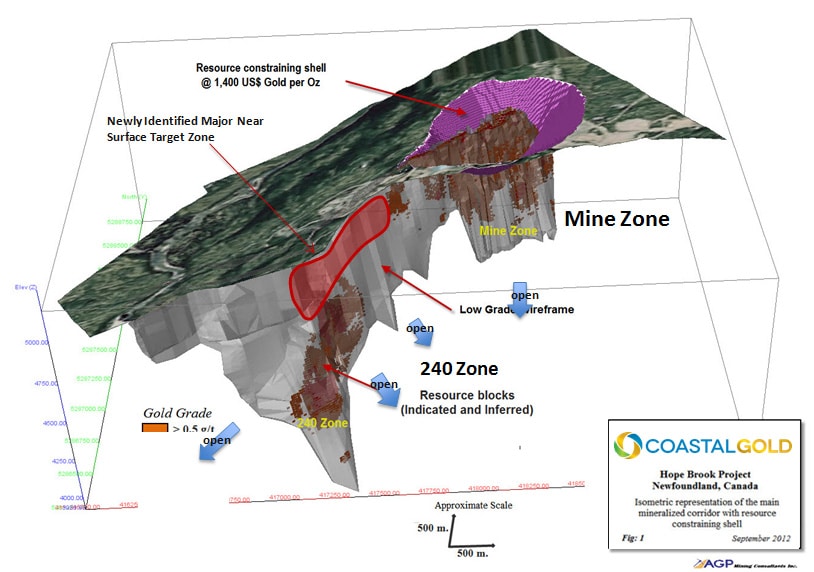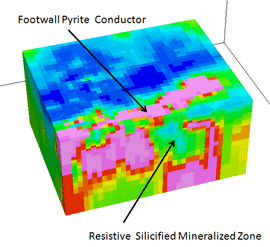The recent decline in gold prices has reinforced the importance of delineating deposits that can withstand the vagaries of the market. Tonnage may have trumped grade during the past decade, when prices were rising. But grade has become king in a stagnant gold price range of US$1200-1400 per oz.
The importance of attracting investors with richer deposits is not lost on Coastal Gold, owner of the Hope Brook Gold project in southwest Newfoundland, a former gold mine with resources of nearly 1.4 million ounces. Although the average grade of the current resource is about 2 grams per tonne, Coastal Gold is attempting to define a higher grade (2-5+ gpt) zone by integrating geophysical and lithogeochemical data within the geological model to steer exploration.
“We have to make a strong case that at current gold prices this project can work,” says President and CEO Bill Pearson. “The more that we can enhance grade, the greater the opportunity to develop a potentially economic mine.”

Hope Brook is a high sulphidation epithermal deposit blessed with a pyritic zone in the footwall that serves as a consistent marker for a silicified zone of mineralization up to 80 m wide and extending for at least five kilometres along strike. Within this lower grade area of earlier silicification is a later, much narrower (5-25 m thick) siliceous brecciated zone containing the high grade.

he pyrite layer – and by extension the larger mineralized zone – is easy to trace using geophysics (IP and electromagnetics), but zeroing in on the higher grade mineralization is much more challenging. That’s where integrating lithogeochemistry into the geological model comes in.
“Geophysics gets us in the ball park, but lithogeochemistry gets us on base,” says Pearson, whose team is collaborating with researchers from Western and Memorial Universities to determine the mineralization style and alteration characteristics of the system, with a particular focus on controls of higher grade mineralization.
Coastal Gold’s search for new areas of higher grade material began in earnest in 2012. After completing 3D inversions of resistivity & electromagnetic data from a Titan 24 airborne survey and importing them into Geosoft Oasis montaj, the company was able to clearly delineate the silicified mineralized zone (resistive) and the pyrite zone (conductive) in the footwall.
Coastal Gold followed up the geophysical survey with a 21-hole reconnaissance drilling program, which hit the mineralized zone in every completed hole. By integrating the geological and geochemical data into Geosoft Target for ArcGIS, Coastal Gold confirmed that the mineralized structure extended over a strike length of 3.4 km. Within this structure, a major new near surface target was identified over a one kilometre strike length about 900 m southwest of the former mine.

More specifically, the exploration team was able to get a much better sense of where the high grade lies within the larger zone by plotting and analyzing the alteration characteristics of the drill core. The higher grade zone is characterized by little to no sodium, higher silica, and copper (as chalcopyrite and lesser bornite) values.
“If we know the mineralization is there, we’ll use the lithogeochemistry to maximize our odds of hitting the high grade,” says Pearson. “If we see the same intense alteration that we see in our higher grade areas, we know the odds favour us to get better results, while weaker alteration suggests we are on the edge and there is no point wasting more money there.”
The lithogeochemical work also helped confirm what the geophysics was saying: that the pyrite zone is a reliable proxy for mineralization; and establish that gold mineralization over the entire property is likely derived from one fluid source, a single event driven by a major magmatic-hydrothermal system at depth.
Further analysis of immobile trace elements confirmed that the geochemistry at Hope Brook has similarities to world-class high sulphidation and porphyry Au-Cu deposits (e.g. Yanacocha, Peru and Lepanto, Phillippines).
BP-Selco discovered the Hope Brook deposit in 1983 and is thought to have outlined a (non NI 43-101 compliant) resource 11.2 million tonnes grading 4.54 gpt gold at a 2.5 gpt cut-off. The deposit was mined from 1987-1997 with total reported production of about 752,000 ounces of gold from underground workings and a small open pit, plus a copper concentrate in the latter years.

After completing definition drilling in 2013, Coastal Gold announced a resource update for the remaining deposit including indicated resources of 1,249,000 oz. and inferred resources of 138,000 oz. Work to date on a preliminary economic assessment (PEA) has focused on the potential production from tailings, open pit and underground at a rate of 5,000 tonnes per day.
Difficult financing conditions for miners have prevented Coastal Gold from chasing down the high grade within the new target. But with renewed investor interest the company will continue exploring the area while completing the PEA for the main deposit.
When that day arrives, the exploration team members’ ongoing efforts to integrate all the geophysical, geochemical and geological from the project on a single platform will serve them well as they strive to maximize hit rates and present information to potential investors in a way that is easy to visualize and understand.
Editor’s Note: On July 7, 2015, First Mining Finance Corp. closed the acquisition of Coastal Gold Corp. which wholly owned the Hope Brook Gold Project.




